Comprehensive Report: Management Accounting for Agmet Chemical Company
VerifiedAdded on 2020/01/28
|18
|5953
|164
Report
AI Summary
This report provides a comprehensive analysis of management accounting practices within Agmet, a chemical producing company. It begins with an introduction to management accounting, its importance, and the different types of systems, including cost accounting and inventory management. The report then delves into various reporting methods, such as ratio analysis and cash flow analysis, and highlights the benefits of a management accounting system, including improved cash flow and decision-making. A critical evaluation of the management accounting system is presented, focusing on relevant cost analysis, activity-based costing, and make-or-buy decisions. The report further explores cost calculation techniques like absorption costing and marginal costing, along with interpretation of data using distinct techniques. It also discusses the advantages and disadvantages of different planning tools used for budgetary control, such as variance analysis and flexible budgeting. The report concludes with a comparison of how different organizations adapt management accounting to address financial problems and an analysis of management accounting's role in achieving sustainable success. The report uses a variety of sources to support its findings.

Management Accounting
Paraphrase This Document
Need a fresh take? Get an instant paraphrase of this document with our AI Paraphraser
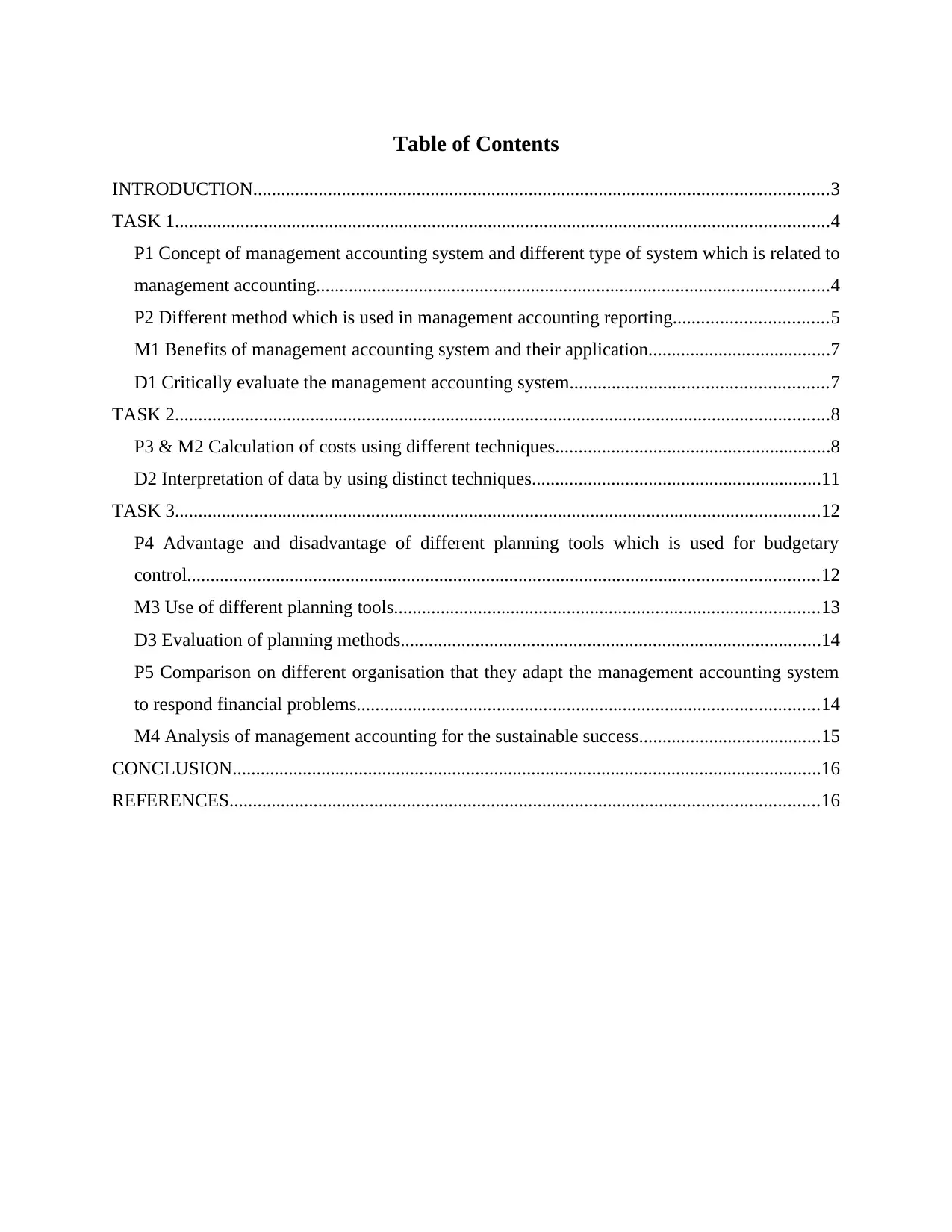
Table of Contents
INTRODUCTION...........................................................................................................................3
TASK 1............................................................................................................................................4
P1 Concept of management accounting system and different type of system which is related to
management accounting..............................................................................................................4
P2 Different method which is used in management accounting reporting.................................5
M1 Benefits of management accounting system and their application.......................................7
D1 Critically evaluate the management accounting system.......................................................7
TASK 2............................................................................................................................................8
P3 & M2 Calculation of costs using different techniques...........................................................8
D2 Interpretation of data by using distinct techniques..............................................................11
TASK 3..........................................................................................................................................12
P4 Advantage and disadvantage of different planning tools which is used for budgetary
control.......................................................................................................................................12
M3 Use of different planning tools...........................................................................................13
D3 Evaluation of planning methods..........................................................................................14
P5 Comparison on different organisation that they adapt the management accounting system
to respond financial problems...................................................................................................14
M4 Analysis of management accounting for the sustainable success.......................................15
CONCLUSION..............................................................................................................................16
REFERENCES..............................................................................................................................16
INTRODUCTION...........................................................................................................................3
TASK 1............................................................................................................................................4
P1 Concept of management accounting system and different type of system which is related to
management accounting..............................................................................................................4
P2 Different method which is used in management accounting reporting.................................5
M1 Benefits of management accounting system and their application.......................................7
D1 Critically evaluate the management accounting system.......................................................7
TASK 2............................................................................................................................................8
P3 & M2 Calculation of costs using different techniques...........................................................8
D2 Interpretation of data by using distinct techniques..............................................................11
TASK 3..........................................................................................................................................12
P4 Advantage and disadvantage of different planning tools which is used for budgetary
control.......................................................................................................................................12
M3 Use of different planning tools...........................................................................................13
D3 Evaluation of planning methods..........................................................................................14
P5 Comparison on different organisation that they adapt the management accounting system
to respond financial problems...................................................................................................14
M4 Analysis of management accounting for the sustainable success.......................................15
CONCLUSION..............................................................................................................................16
REFERENCES..............................................................................................................................16

⊘ This is a preview!⊘
Do you want full access?
Subscribe today to unlock all pages.

Trusted by 1+ million students worldwide
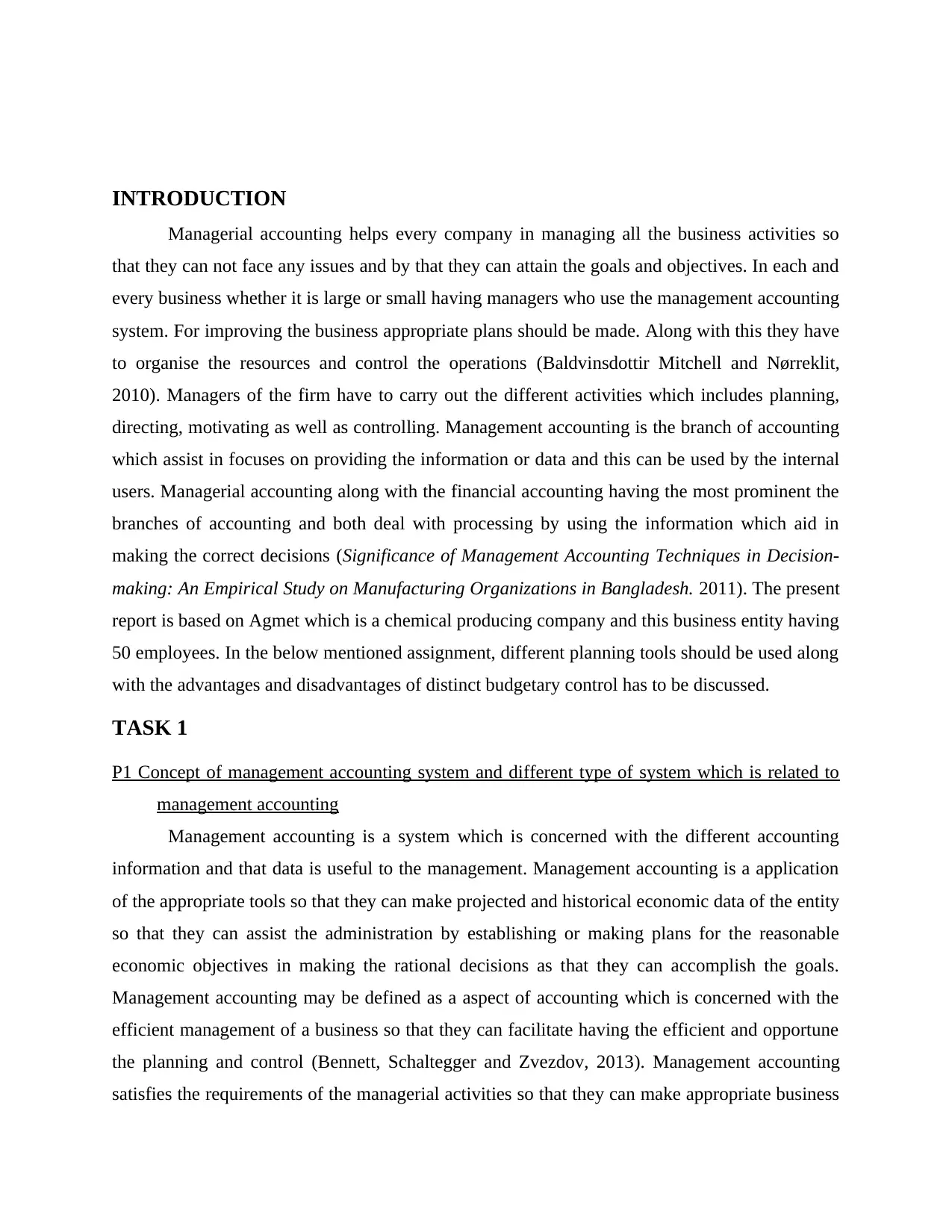
INTRODUCTION
Managerial accounting helps every company in managing all the business activities so
that they can not face any issues and by that they can attain the goals and objectives. In each and
every business whether it is large or small having managers who use the management accounting
system. For improving the business appropriate plans should be made. Along with this they have
to organise the resources and control the operations (Baldvinsdottir Mitchell and Nørreklit,
2010). Managers of the firm have to carry out the different activities which includes planning,
directing, motivating as well as controlling. Management accounting is the branch of accounting
which assist in focuses on providing the information or data and this can be used by the internal
users. Managerial accounting along with the financial accounting having the most prominent the
branches of accounting and both deal with processing by using the information which aid in
making the correct decisions (Significance of Management Accounting Techniques in Decision-
making: An Empirical Study on Manufacturing Organizations in Bangladesh. 2011). The present
report is based on Agmet which is a chemical producing company and this business entity having
50 employees. In the below mentioned assignment, different planning tools should be used along
with the advantages and disadvantages of distinct budgetary control has to be discussed.
TASK 1
P1 Concept of management accounting system and different type of system which is related to
management accounting
Management accounting is a system which is concerned with the different accounting
information and that data is useful to the management. Management accounting is a application
of the appropriate tools so that they can make projected and historical economic data of the entity
so that they can assist the administration by establishing or making plans for the reasonable
economic objectives in making the rational decisions as that they can accomplish the goals.
Management accounting may be defined as a aspect of accounting which is concerned with the
efficient management of a business so that they can facilitate having the efficient and opportune
the planning and control (Bennett, Schaltegger and Zvezdov, 2013). Management accounting
satisfies the requirements of the managerial activities so that they can make appropriate business
Managerial accounting helps every company in managing all the business activities so
that they can not face any issues and by that they can attain the goals and objectives. In each and
every business whether it is large or small having managers who use the management accounting
system. For improving the business appropriate plans should be made. Along with this they have
to organise the resources and control the operations (Baldvinsdottir Mitchell and Nørreklit,
2010). Managers of the firm have to carry out the different activities which includes planning,
directing, motivating as well as controlling. Management accounting is the branch of accounting
which assist in focuses on providing the information or data and this can be used by the internal
users. Managerial accounting along with the financial accounting having the most prominent the
branches of accounting and both deal with processing by using the information which aid in
making the correct decisions (Significance of Management Accounting Techniques in Decision-
making: An Empirical Study on Manufacturing Organizations in Bangladesh. 2011). The present
report is based on Agmet which is a chemical producing company and this business entity having
50 employees. In the below mentioned assignment, different planning tools should be used along
with the advantages and disadvantages of distinct budgetary control has to be discussed.
TASK 1
P1 Concept of management accounting system and different type of system which is related to
management accounting
Management accounting is a system which is concerned with the different accounting
information and that data is useful to the management. Management accounting is a application
of the appropriate tools so that they can make projected and historical economic data of the entity
so that they can assist the administration by establishing or making plans for the reasonable
economic objectives in making the rational decisions as that they can accomplish the goals.
Management accounting may be defined as a aspect of accounting which is concerned with the
efficient management of a business so that they can facilitate having the efficient and opportune
the planning and control (Bennett, Schaltegger and Zvezdov, 2013). Management accounting
satisfies the requirements of the managerial activities so that they can make appropriate business
Paraphrase This Document
Need a fresh take? Get an instant paraphrase of this document with our AI Paraphraser

decision by doing the modification of data. Along with this they staff members of Agmet have to
analyse and interpret the data for the effective planning and on the basis of that effective and
relevant decision can be made. For analysis of data they can use different methods that is
comparative financial statements, common size statements as well as ratio analysis. They have to
facilitate the management control and company employees have to put more efforts so that they
can directed towards the attainment of goals by which they can control the operations of Agmet
more effectively (Busco and Scapens, 2011). The staff members have to use the qualitative
information and supervisor need qualitative information and data which can not be readily
converted into monetary terms. By using the informational needs at the different level of
management which succour in providing the satisfaction to their employees and consumers.
Different type of management accounting system are:
Basis Description
Cost accounting system It is also known as product costing system which is a
framework and used by Agmet so that every manager or leader
can estimate the cost of their products and services which aid
in improving the profitability and probability analysis,
inventory valuation and cost control. They have to estimate the
accurate the cost of products which is critical for the profitable
operations (Christ and Burritt, 2013).
Inventory management system It is a software which is a computer based system so that they
can track the inventory levels, orders, sales as well as
deliveries. It can be used in the manufacturing industry so that
they can create a work order, a bill of materials and other
documents which are related to production.
Throughput system It is a principle based system as well as management
accounting approach which provides the manager to make
effective decision so that they can support information for the
profitability improvements.
Pricing optimisation This system assist in doing the mathematical analysis by
Agmet so that they can determine that how consumers will
analyse and interpret the data for the effective planning and on the basis of that effective and
relevant decision can be made. For analysis of data they can use different methods that is
comparative financial statements, common size statements as well as ratio analysis. They have to
facilitate the management control and company employees have to put more efforts so that they
can directed towards the attainment of goals by which they can control the operations of Agmet
more effectively (Busco and Scapens, 2011). The staff members have to use the qualitative
information and supervisor need qualitative information and data which can not be readily
converted into monetary terms. By using the informational needs at the different level of
management which succour in providing the satisfaction to their employees and consumers.
Different type of management accounting system are:
Basis Description
Cost accounting system It is also known as product costing system which is a
framework and used by Agmet so that every manager or leader
can estimate the cost of their products and services which aid
in improving the profitability and probability analysis,
inventory valuation and cost control. They have to estimate the
accurate the cost of products which is critical for the profitable
operations (Christ and Burritt, 2013).
Inventory management system It is a software which is a computer based system so that they
can track the inventory levels, orders, sales as well as
deliveries. It can be used in the manufacturing industry so that
they can create a work order, a bill of materials and other
documents which are related to production.
Throughput system It is a principle based system as well as management
accounting approach which provides the manager to make
effective decision so that they can support information for the
profitability improvements.
Pricing optimisation This system assist in doing the mathematical analysis by
Agmet so that they can determine that how consumers will
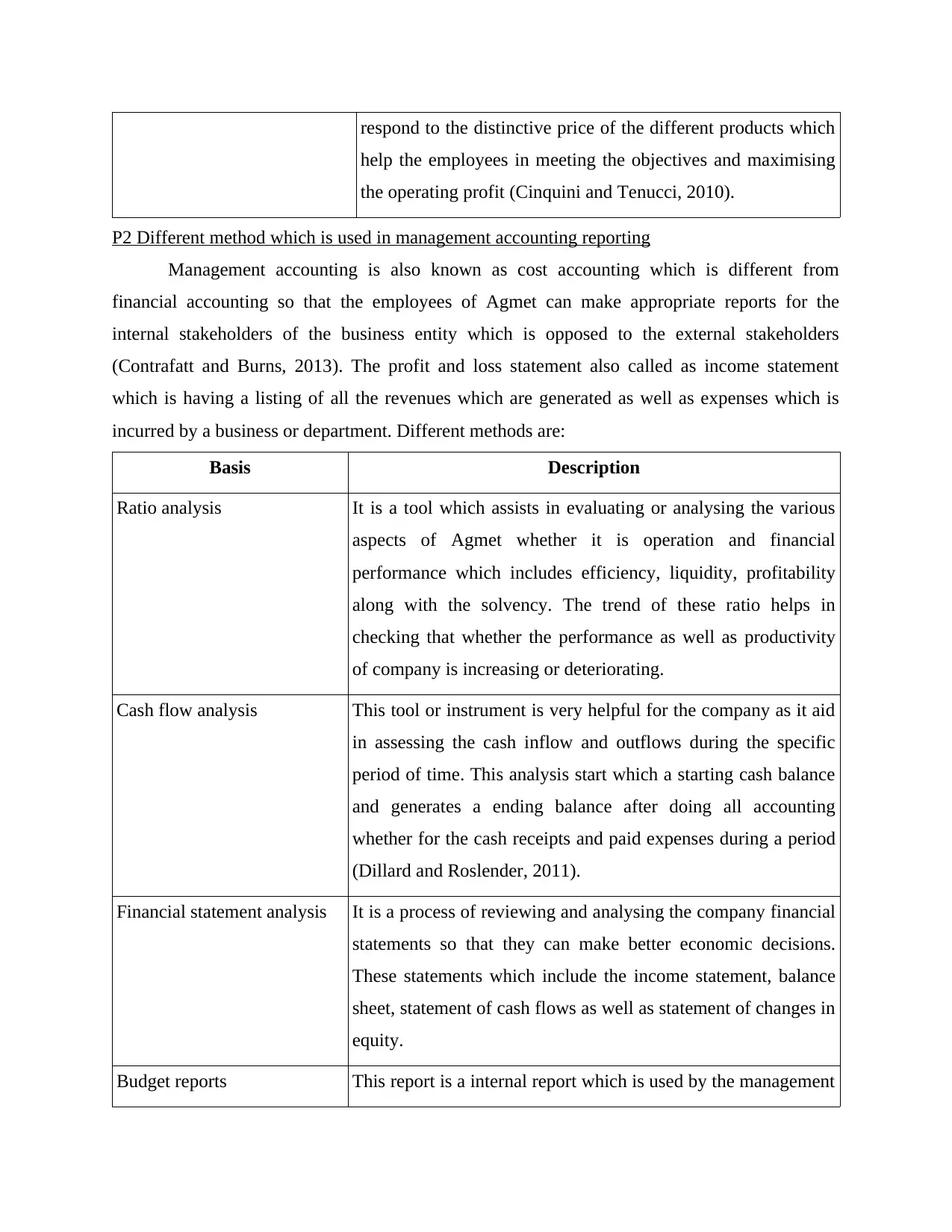
respond to the distinctive price of the different products which
help the employees in meeting the objectives and maximising
the operating profit (Cinquini and Tenucci, 2010).
P2 Different method which is used in management accounting reporting
Management accounting is also known as cost accounting which is different from
financial accounting so that the employees of Agmet can make appropriate reports for the
internal stakeholders of the business entity which is opposed to the external stakeholders
(Contrafatt and Burns, 2013). The profit and loss statement also called as income statement
which is having a listing of all the revenues which are generated as well as expenses which is
incurred by a business or department. Different methods are:
Basis Description
Ratio analysis It is a tool which assists in evaluating or analysing the various
aspects of Agmet whether it is operation and financial
performance which includes efficiency, liquidity, profitability
along with the solvency. The trend of these ratio helps in
checking that whether the performance as well as productivity
of company is increasing or deteriorating.
Cash flow analysis This tool or instrument is very helpful for the company as it aid
in assessing the cash inflow and outflows during the specific
period of time. This analysis start which a starting cash balance
and generates a ending balance after doing all accounting
whether for the cash receipts and paid expenses during a period
(Dillard and Roslender, 2011).
Financial statement analysis It is a process of reviewing and analysing the company financial
statements so that they can make better economic decisions.
These statements which include the income statement, balance
sheet, statement of cash flows as well as statement of changes in
equity.
Budget reports This report is a internal report which is used by the management
help the employees in meeting the objectives and maximising
the operating profit (Cinquini and Tenucci, 2010).
P2 Different method which is used in management accounting reporting
Management accounting is also known as cost accounting which is different from
financial accounting so that the employees of Agmet can make appropriate reports for the
internal stakeholders of the business entity which is opposed to the external stakeholders
(Contrafatt and Burns, 2013). The profit and loss statement also called as income statement
which is having a listing of all the revenues which are generated as well as expenses which is
incurred by a business or department. Different methods are:
Basis Description
Ratio analysis It is a tool which assists in evaluating or analysing the various
aspects of Agmet whether it is operation and financial
performance which includes efficiency, liquidity, profitability
along with the solvency. The trend of these ratio helps in
checking that whether the performance as well as productivity
of company is increasing or deteriorating.
Cash flow analysis This tool or instrument is very helpful for the company as it aid
in assessing the cash inflow and outflows during the specific
period of time. This analysis start which a starting cash balance
and generates a ending balance after doing all accounting
whether for the cash receipts and paid expenses during a period
(Dillard and Roslender, 2011).
Financial statement analysis It is a process of reviewing and analysing the company financial
statements so that they can make better economic decisions.
These statements which include the income statement, balance
sheet, statement of cash flows as well as statement of changes in
equity.
Budget reports This report is a internal report which is used by the management
⊘ This is a preview!⊘
Do you want full access?
Subscribe today to unlock all pages.

Trusted by 1+ million students worldwide
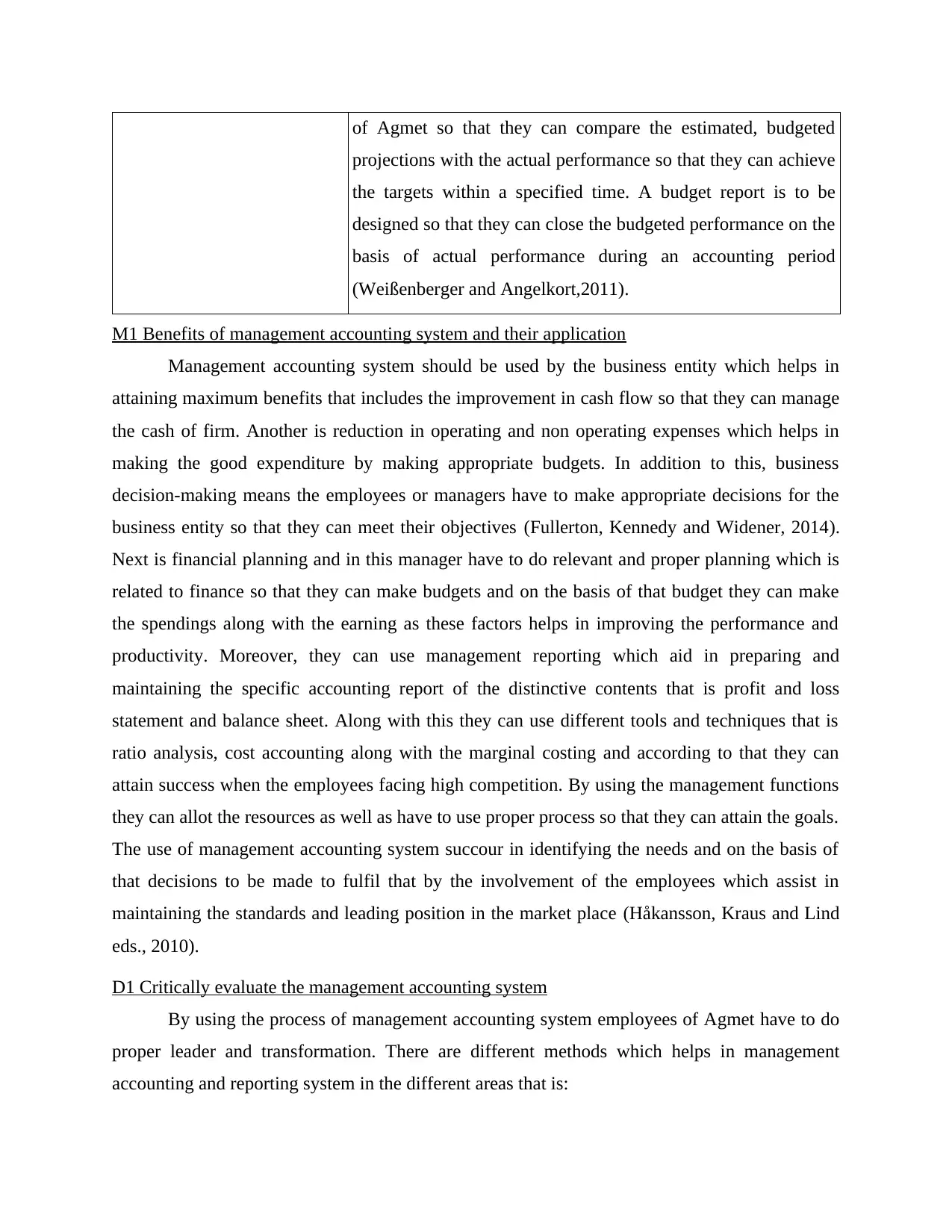
of Agmet so that they can compare the estimated, budgeted
projections with the actual performance so that they can achieve
the targets within a specified time. A budget report is to be
designed so that they can close the budgeted performance on the
basis of actual performance during an accounting period
(Weißenberger and Angelkort,2011).
M1 Benefits of management accounting system and their application
Management accounting system should be used by the business entity which helps in
attaining maximum benefits that includes the improvement in cash flow so that they can manage
the cash of firm. Another is reduction in operating and non operating expenses which helps in
making the good expenditure by making appropriate budgets. In addition to this, business
decision-making means the employees or managers have to make appropriate decisions for the
business entity so that they can meet their objectives (Fullerton, Kennedy and Widener, 2014).
Next is financial planning and in this manager have to do relevant and proper planning which is
related to finance so that they can make budgets and on the basis of that budget they can make
the spendings along with the earning as these factors helps in improving the performance and
productivity. Moreover, they can use management reporting which aid in preparing and
maintaining the specific accounting report of the distinctive contents that is profit and loss
statement and balance sheet. Along with this they can use different tools and techniques that is
ratio analysis, cost accounting along with the marginal costing and according to that they can
attain success when the employees facing high competition. By using the management functions
they can allot the resources as well as have to use proper process so that they can attain the goals.
The use of management accounting system succour in identifying the needs and on the basis of
that decisions to be made to fulfil that by the involvement of the employees which assist in
maintaining the standards and leading position in the market place (Håkansson, Kraus and Lind
eds., 2010).
D1 Critically evaluate the management accounting system
By using the process of management accounting system employees of Agmet have to do
proper leader and transformation. There are different methods which helps in management
accounting and reporting system in the different areas that is:
projections with the actual performance so that they can achieve
the targets within a specified time. A budget report is to be
designed so that they can close the budgeted performance on the
basis of actual performance during an accounting period
(Weißenberger and Angelkort,2011).
M1 Benefits of management accounting system and their application
Management accounting system should be used by the business entity which helps in
attaining maximum benefits that includes the improvement in cash flow so that they can manage
the cash of firm. Another is reduction in operating and non operating expenses which helps in
making the good expenditure by making appropriate budgets. In addition to this, business
decision-making means the employees or managers have to make appropriate decisions for the
business entity so that they can meet their objectives (Fullerton, Kennedy and Widener, 2014).
Next is financial planning and in this manager have to do relevant and proper planning which is
related to finance so that they can make budgets and on the basis of that budget they can make
the spendings along with the earning as these factors helps in improving the performance and
productivity. Moreover, they can use management reporting which aid in preparing and
maintaining the specific accounting report of the distinctive contents that is profit and loss
statement and balance sheet. Along with this they can use different tools and techniques that is
ratio analysis, cost accounting along with the marginal costing and according to that they can
attain success when the employees facing high competition. By using the management functions
they can allot the resources as well as have to use proper process so that they can attain the goals.
The use of management accounting system succour in identifying the needs and on the basis of
that decisions to be made to fulfil that by the involvement of the employees which assist in
maintaining the standards and leading position in the market place (Håkansson, Kraus and Lind
eds., 2010).
D1 Critically evaluate the management accounting system
By using the process of management accounting system employees of Agmet have to do
proper leader and transformation. There are different methods which helps in management
accounting and reporting system in the different areas that is:
Paraphrase This Document
Need a fresh take? Get an instant paraphrase of this document with our AI Paraphraser

Relevant cost analysis: This can be used for evaluating the relevant cost. Here relevant
cost refers to the cost which having a impact on the process of decision making of Agmet and its
administration. Management Accounting as well as reporting which aid in providing the relevant
information related to cost to the employees of Agmet (Herbert and Seal, 2012). Along with this,
it helps the management in making more efficient decision for business enterprise. Variable cost
of the product can be considered as the relevant cost as changes on the basis of change in
quantity and volume of production. Where as fixed cost of merchandise does not change in the
production level as it is not related with the relevant cost.
Activity based costing methods: This method helps Agmet in ascertaining that who will
be the consumers of the company and it also aid in identifying the wants and desires of them.
Activity based costing method helps in making the changes in the activities. Once service user
get known by Agmet or when company is able to identify its more beneficial to end users the
company will than focus the advertising efforts on that customers (Hiebl, 2014).
Make or buy analysis: The supervising of cited enterprise can analyse that what they want
to purchase from outsiders as well as what they can produce in the business entity. If making a
merchandise will proof more costly to the employees of Agmet than in this situation it will be
better for business enterprise to buy it from the outside. While if equipments which are using in
the enterprise is very cheap than the corporation should produce qualitative products.
Utilising the data: The employees as well as managers of Agmet have to use or utilise the
appropriate data so that they can manage all the operational activities. The management
accounting along with the reporting provide the manager necessary and essential information.
Further, by using this information or data they can attain success in future (Ward, 2012).
TASK 2
P3 & M2 Calculation of costs using different techniques
Absorption costing: It is a method which assist in doing the inventory valuation on the
basis of all the manufacturing expenses which are allocated to the cost centres so that they
recognise the total cost of production. It is a traditional method for the ascertainment of cost and
in this both fixed as well as variable cost are related to product cost (Jansen, 2011). There are
different type of absorption costing which includes activity based costing, job costing as well as
process costing.
cost refers to the cost which having a impact on the process of decision making of Agmet and its
administration. Management Accounting as well as reporting which aid in providing the relevant
information related to cost to the employees of Agmet (Herbert and Seal, 2012). Along with this,
it helps the management in making more efficient decision for business enterprise. Variable cost
of the product can be considered as the relevant cost as changes on the basis of change in
quantity and volume of production. Where as fixed cost of merchandise does not change in the
production level as it is not related with the relevant cost.
Activity based costing methods: This method helps Agmet in ascertaining that who will
be the consumers of the company and it also aid in identifying the wants and desires of them.
Activity based costing method helps in making the changes in the activities. Once service user
get known by Agmet or when company is able to identify its more beneficial to end users the
company will than focus the advertising efforts on that customers (Hiebl, 2014).
Make or buy analysis: The supervising of cited enterprise can analyse that what they want
to purchase from outsiders as well as what they can produce in the business entity. If making a
merchandise will proof more costly to the employees of Agmet than in this situation it will be
better for business enterprise to buy it from the outside. While if equipments which are using in
the enterprise is very cheap than the corporation should produce qualitative products.
Utilising the data: The employees as well as managers of Agmet have to use or utilise the
appropriate data so that they can manage all the operational activities. The management
accounting along with the reporting provide the manager necessary and essential information.
Further, by using this information or data they can attain success in future (Ward, 2012).
TASK 2
P3 & M2 Calculation of costs using different techniques
Absorption costing: It is a method which assist in doing the inventory valuation on the
basis of all the manufacturing expenses which are allocated to the cost centres so that they
recognise the total cost of production. It is a traditional method for the ascertainment of cost and
in this both fixed as well as variable cost are related to product cost (Jansen, 2011). There are
different type of absorption costing which includes activity based costing, job costing as well as
process costing.

Income statement on the basis of Absorption costing method:
Selling Price £35
Unit costs
Direct materials £6
Direct Labour £5
Variable Production overhead £2
Variable sales overhead £1
Budgeted production for the period is 600 units
Fixed cost for a month:
Production overhead: In this budgeted cost is £1,800 and Actual cost is £2,000
Administration Cost: In this budgeted cost is £800 and Actual cost is £700
Selling cost: In this budgeted cost is £400 and Actual cost is £600
Absorption costing
Working 1: Calculate full production cost
Direct material £6
Direct labour £5
Variable cost £3
Fixed cost £5
Total £19
Working 2: calculate value of inventory and production
Opening inventory Production Closing inventory
0 700*19 = £13300 100*19 = £1900
Working 3: under/ over absorbed fixed production overhead
Actual fixed production: £3300
Fixed overhead: £3500
Total £200(over absorbed)
Selling Price £35
Unit costs
Direct materials £6
Direct Labour £5
Variable Production overhead £2
Variable sales overhead £1
Budgeted production for the period is 600 units
Fixed cost for a month:
Production overhead: In this budgeted cost is £1,800 and Actual cost is £2,000
Administration Cost: In this budgeted cost is £800 and Actual cost is £700
Selling cost: In this budgeted cost is £400 and Actual cost is £600
Absorption costing
Working 1: Calculate full production cost
Direct material £6
Direct labour £5
Variable cost £3
Fixed cost £5
Total £19
Working 2: calculate value of inventory and production
Opening inventory Production Closing inventory
0 700*19 = £13300 100*19 = £1900
Working 3: under/ over absorbed fixed production overhead
Actual fixed production: £3300
Fixed overhead: £3500
Total £200(over absorbed)
⊘ This is a preview!⊘
Do you want full access?
Subscribe today to unlock all pages.

Trusted by 1+ million students worldwide
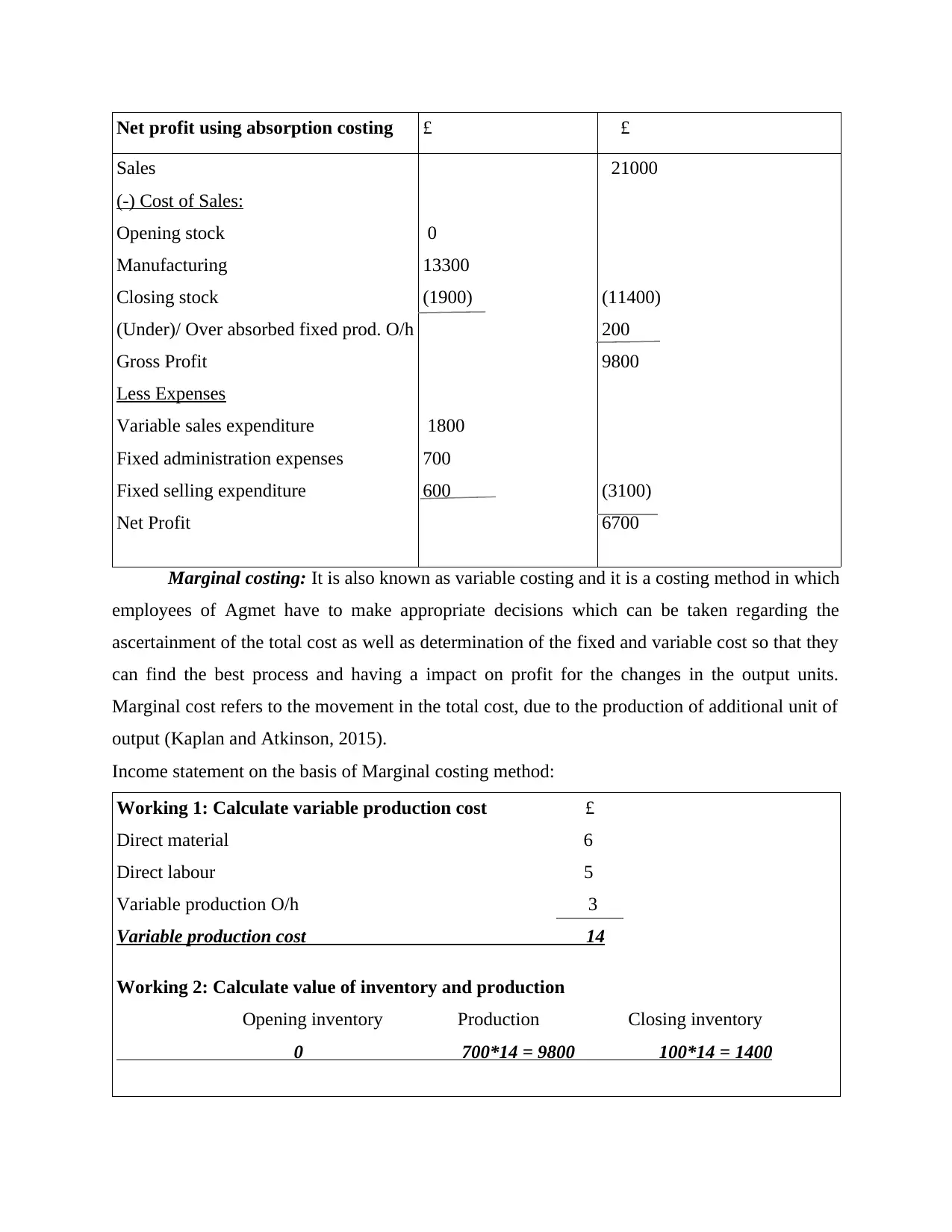
Net profit using absorption costing £ £
Sales
(-) Cost of Sales:
Opening stock
Manufacturing
Closing stock
(Under)/ Over absorbed fixed prod. O/h
Gross Profit
Less Expenses
Variable sales expenditure
Fixed administration expenses
Fixed selling expenditure
Net Profit
0
13300
(1900)
1800
700
600
21000
(11400)
200
9800
(3100)
6700
Marginal costing: It is also known as variable costing and it is a costing method in which
employees of Agmet have to make appropriate decisions which can be taken regarding the
ascertainment of the total cost as well as determination of the fixed and variable cost so that they
can find the best process and having a impact on profit for the changes in the output units.
Marginal cost refers to the movement in the total cost, due to the production of additional unit of
output (Kaplan and Atkinson, 2015).
Income statement on the basis of Marginal costing method:
Working 1: Calculate variable production cost £
Direct material 6
Direct labour 5
Variable production O/h 3
Variable production cost 14
Working 2: Calculate value of inventory and production
Opening inventory Production Closing inventory
0 700*14 = 9800 100*14 = 1400
Sales
(-) Cost of Sales:
Opening stock
Manufacturing
Closing stock
(Under)/ Over absorbed fixed prod. O/h
Gross Profit
Less Expenses
Variable sales expenditure
Fixed administration expenses
Fixed selling expenditure
Net Profit
0
13300
(1900)
1800
700
600
21000
(11400)
200
9800
(3100)
6700
Marginal costing: It is also known as variable costing and it is a costing method in which
employees of Agmet have to make appropriate decisions which can be taken regarding the
ascertainment of the total cost as well as determination of the fixed and variable cost so that they
can find the best process and having a impact on profit for the changes in the output units.
Marginal cost refers to the movement in the total cost, due to the production of additional unit of
output (Kaplan and Atkinson, 2015).
Income statement on the basis of Marginal costing method:
Working 1: Calculate variable production cost £
Direct material 6
Direct labour 5
Variable production O/h 3
Variable production cost 14
Working 2: Calculate value of inventory and production
Opening inventory Production Closing inventory
0 700*14 = 9800 100*14 = 1400
Paraphrase This Document
Need a fresh take? Get an instant paraphrase of this document with our AI Paraphraser
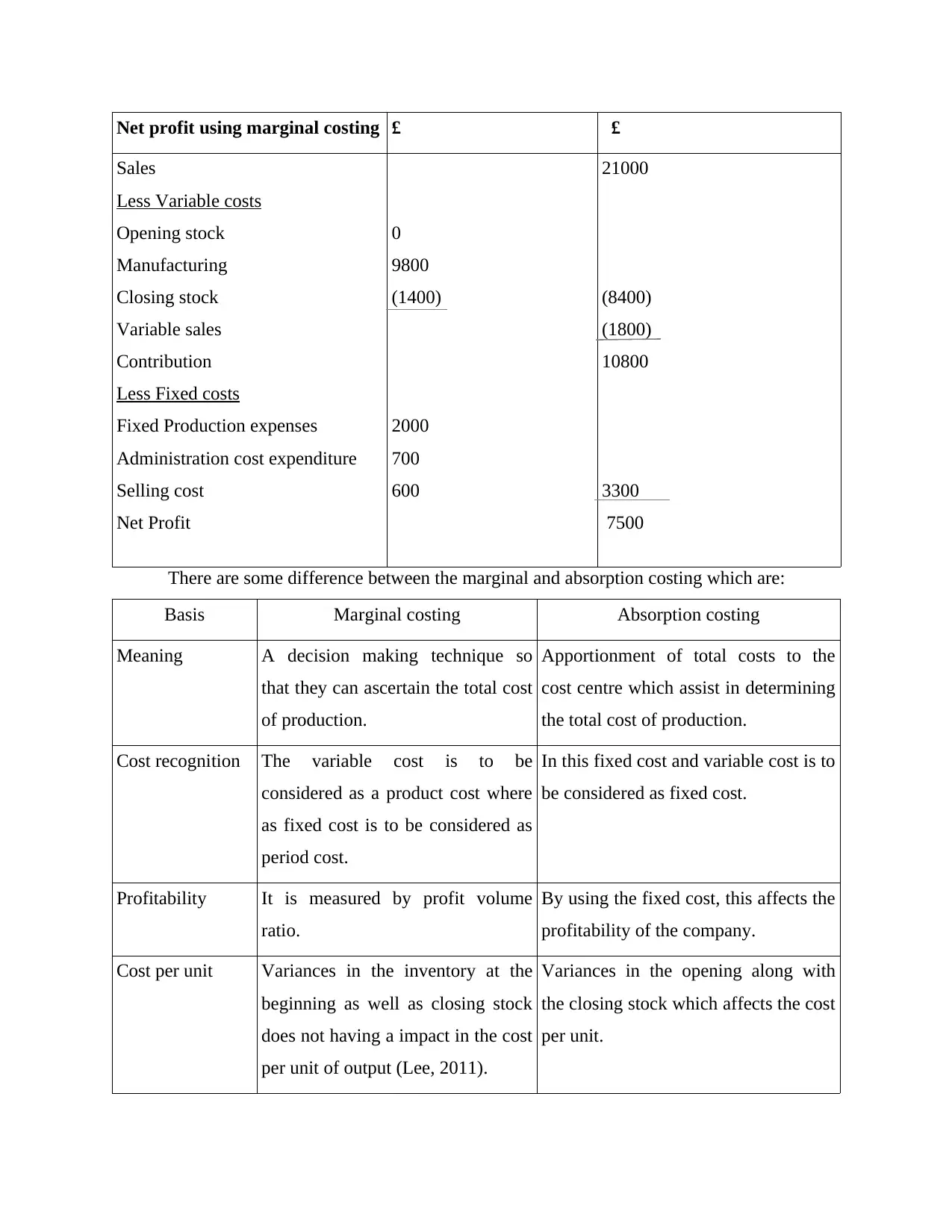
Net profit using marginal costing £ £
Sales
Less Variable costs
Opening stock
Manufacturing
Closing stock
Variable sales
Contribution
Less Fixed costs
Fixed Production expenses
Administration cost expenditure
Selling cost
Net Profit
0
9800
(1400)
2000
700
600
21000
(8400)
(1800)
10800
3300
7500
There are some difference between the marginal and absorption costing which are:
Basis Marginal costing Absorption costing
Meaning A decision making technique so
that they can ascertain the total cost
of production.
Apportionment of total costs to the
cost centre which assist in determining
the total cost of production.
Cost recognition The variable cost is to be
considered as a product cost where
as fixed cost is to be considered as
period cost.
In this fixed cost and variable cost is to
be considered as fixed cost.
Profitability It is measured by profit volume
ratio.
By using the fixed cost, this affects the
profitability of the company.
Cost per unit Variances in the inventory at the
beginning as well as closing stock
does not having a impact in the cost
per unit of output (Lee, 2011).
Variances in the opening along with
the closing stock which affects the cost
per unit.
Sales
Less Variable costs
Opening stock
Manufacturing
Closing stock
Variable sales
Contribution
Less Fixed costs
Fixed Production expenses
Administration cost expenditure
Selling cost
Net Profit
0
9800
(1400)
2000
700
600
21000
(8400)
(1800)
10800
3300
7500
There are some difference between the marginal and absorption costing which are:
Basis Marginal costing Absorption costing
Meaning A decision making technique so
that they can ascertain the total cost
of production.
Apportionment of total costs to the
cost centre which assist in determining
the total cost of production.
Cost recognition The variable cost is to be
considered as a product cost where
as fixed cost is to be considered as
period cost.
In this fixed cost and variable cost is to
be considered as fixed cost.
Profitability It is measured by profit volume
ratio.
By using the fixed cost, this affects the
profitability of the company.
Cost per unit Variances in the inventory at the
beginning as well as closing stock
does not having a impact in the cost
per unit of output (Lee, 2011).
Variances in the opening along with
the closing stock which affects the cost
per unit.
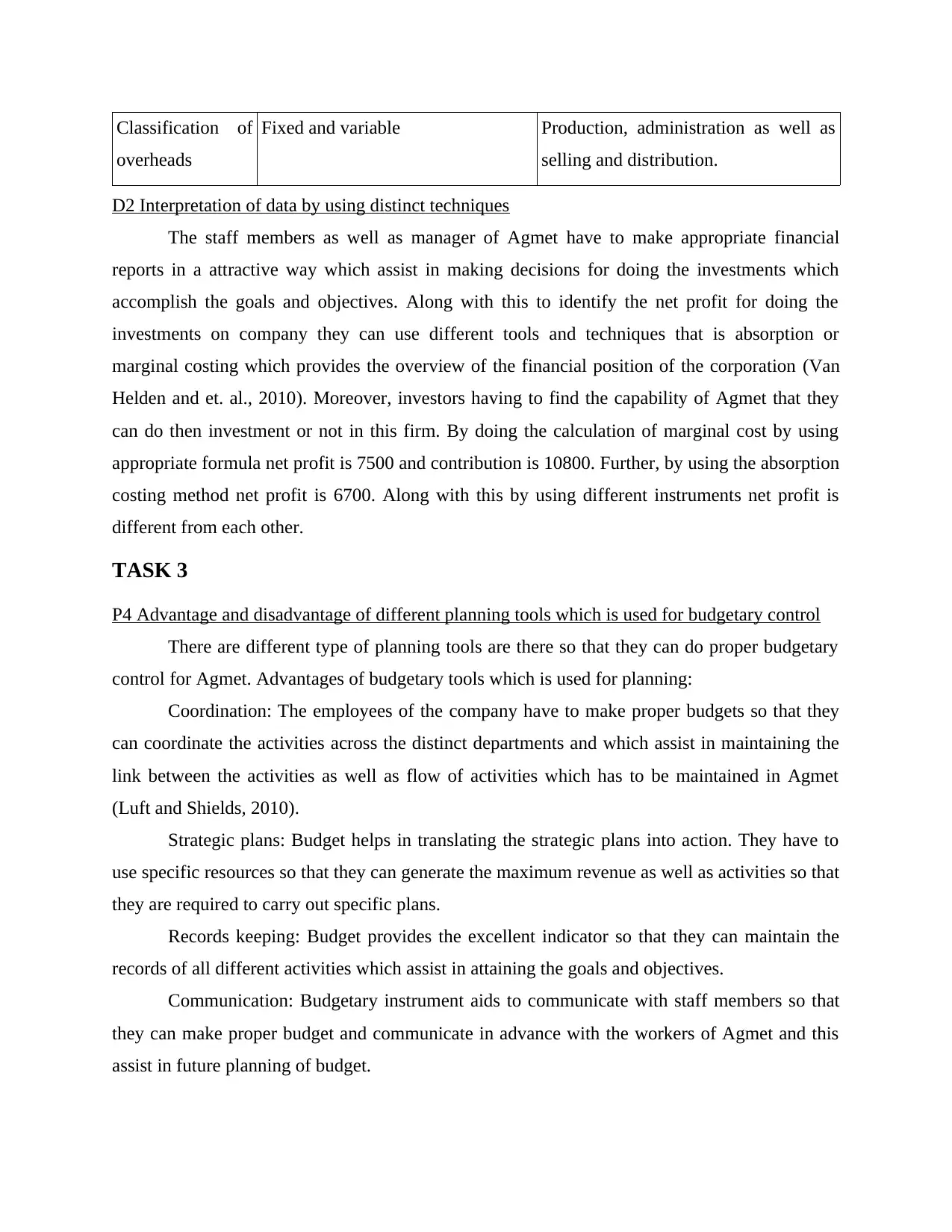
Classification of
overheads
Fixed and variable Production, administration as well as
selling and distribution.
D2 Interpretation of data by using distinct techniques
The staff members as well as manager of Agmet have to make appropriate financial
reports in a attractive way which assist in making decisions for doing the investments which
accomplish the goals and objectives. Along with this to identify the net profit for doing the
investments on company they can use different tools and techniques that is absorption or
marginal costing which provides the overview of the financial position of the corporation (Van
Helden and et. al., 2010). Moreover, investors having to find the capability of Agmet that they
can do then investment or not in this firm. By doing the calculation of marginal cost by using
appropriate formula net profit is 7500 and contribution is 10800. Further, by using the absorption
costing method net profit is 6700. Along with this by using different instruments net profit is
different from each other.
TASK 3
P4 Advantage and disadvantage of different planning tools which is used for budgetary control
There are different type of planning tools are there so that they can do proper budgetary
control for Agmet. Advantages of budgetary tools which is used for planning:
Coordination: The employees of the company have to make proper budgets so that they
can coordinate the activities across the distinct departments and which assist in maintaining the
link between the activities as well as flow of activities which has to be maintained in Agmet
(Luft and Shields, 2010).
Strategic plans: Budget helps in translating the strategic plans into action. They have to
use specific resources so that they can generate the maximum revenue as well as activities so that
they are required to carry out specific plans.
Records keeping: Budget provides the excellent indicator so that they can maintain the
records of all different activities which assist in attaining the goals and objectives.
Communication: Budgetary instrument aids to communicate with staff members so that
they can make proper budget and communicate in advance with the workers of Agmet and this
assist in future planning of budget.
overheads
Fixed and variable Production, administration as well as
selling and distribution.
D2 Interpretation of data by using distinct techniques
The staff members as well as manager of Agmet have to make appropriate financial
reports in a attractive way which assist in making decisions for doing the investments which
accomplish the goals and objectives. Along with this to identify the net profit for doing the
investments on company they can use different tools and techniques that is absorption or
marginal costing which provides the overview of the financial position of the corporation (Van
Helden and et. al., 2010). Moreover, investors having to find the capability of Agmet that they
can do then investment or not in this firm. By doing the calculation of marginal cost by using
appropriate formula net profit is 7500 and contribution is 10800. Further, by using the absorption
costing method net profit is 6700. Along with this by using different instruments net profit is
different from each other.
TASK 3
P4 Advantage and disadvantage of different planning tools which is used for budgetary control
There are different type of planning tools are there so that they can do proper budgetary
control for Agmet. Advantages of budgetary tools which is used for planning:
Coordination: The employees of the company have to make proper budgets so that they
can coordinate the activities across the distinct departments and which assist in maintaining the
link between the activities as well as flow of activities which has to be maintained in Agmet
(Luft and Shields, 2010).
Strategic plans: Budget helps in translating the strategic plans into action. They have to
use specific resources so that they can generate the maximum revenue as well as activities so that
they are required to carry out specific plans.
Records keeping: Budget provides the excellent indicator so that they can maintain the
records of all different activities which assist in attaining the goals and objectives.
Communication: Budgetary instrument aids to communicate with staff members so that
they can make proper budget and communicate in advance with the workers of Agmet and this
assist in future planning of budget.
⊘ This is a preview!⊘
Do you want full access?
Subscribe today to unlock all pages.

Trusted by 1+ million students worldwide
1 out of 18
Related Documents
Your All-in-One AI-Powered Toolkit for Academic Success.
+13062052269
info@desklib.com
Available 24*7 on WhatsApp / Email
![[object Object]](/_next/static/media/star-bottom.7253800d.svg)
Unlock your academic potential
Copyright © 2020–2025 A2Z Services. All Rights Reserved. Developed and managed by ZUCOL.





